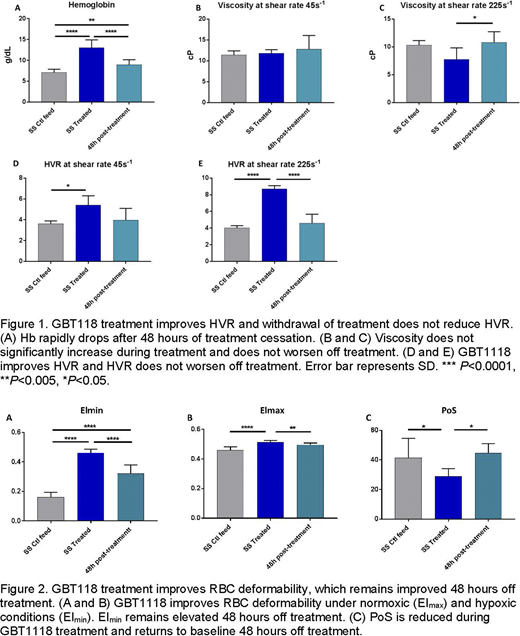Background: In sickle cell disease (SCD), elevated blood viscosity is a risk factor for vaso-occlusive crisis (VOC). Blood viscosity is influenced by hemoglobin (Hb) levels, red blood cell (RBC) deformability, density, and aggregation. Voxelotor is an HbS polymerization inhibitor that increases the Hb affinity for oxygen and reduces sickling. In human subjects, voxelotor significantly increases Hb levels. A rise in Hb due to voxelotor does not increase blood viscosity the way a similar increase in unmodified HbS would. However, voxelotor transiently modifies HbS, raising concern that if voxelotor was stopped suddenly, the drug induced extra HbS would revert to its unmodified state, causing a significant rise in blood viscosity and increasing the risk of VOC. This effect could continue until the drug induced Hb is eliminated by hemolysis. To investigate this, we treated a sickle mouse model with GBT1118, a voxelotor analog. We then stopped the treatment and determined the effect on whole blood viscosity, the hematocrit-to-viscosity ratio (HVR), a measure of oxygen carrying capacity, and RBC deformability. As GBT1118 has a half-life of 14 hours in SCD mouse, we measured the post-drug effect 48 hours after drug withdrawal.
Methods: Ten Townes HbSS mice were fed control chow, 10 were fed chow containing GBT1118 for 7 days, 10 were fed GBT1118 chow for 7 days, and then returned to control chow for 48 hours. RBC deformability was measured by oxygen gradient ektacytometry (Lorrca with Oxygenscan, RR Mechatronics). Blood viscosity was measured with a cone and plate viscometer (Brookfield DVII+). Hb was measured via ADVIA (Siemens).
Results: Treatment with GBT1118 significantly increased Hb without increasing blood viscosity. HVR was increased at both 45 s-1 and 225 s-1 shear rates (Figure 1). GBT1118 treatment also improved RBC deformability under both normoxic (EImax) and hypoxic conditions (EImin). Point of sickling (PoS) was reduced, indicating that treated RBC tolerated lower oxygen concentrations before sickling (Figure 2). When the drug was withdrawn for 48 hours, compared to control animals, 1) Hb declined rapidly (7.1 g/dL in control feed, 13.1 g/dL in treated mice compared to 9.0 g/dL after 48 hours off treatment, P<0.001); 2) viscosity did not increase compared to control feed (at shear rate 45 s-1, 12.8 cP after treatment compared to 11.4 cP in control cohort; at shear rate 225 s-1,10.8 cP after treatment compared to 10.3 cP in controls); 3) HVR returned to baseline (at shear rate 45 s-1, 4.5 after treatment compared to 3.6 in controls; at shear rate 225 s-1, 6.6 after treatment compared to 4 cP in controls), 4) EImin remained elevated (0.16 in controls compared to 0.32 after 48 hours off treatment, P<0.001); 5) Elmax and PoS were not significantly different.
Conclusions: The GBT1118-treated sickle mouse had a significant rise in Hb and improvement in PoS and deformability. Forty-eight hours after removing the analog compound, Hb dropped markedly, and the PoS was not different from control animals, suggesting a return to native oxygen affinity and clearance of the drug. Interestingly, deformability (EImin) did not return to baseline, suggesting some residual rheological improvement occurred in the red cell population that did not dissipate when the drug was cleared. These data suggest that potential concerns regarding viscosity rising above pre-treatment levels upon sudden cessation of voxelotor are not warranted. This may be due to retained improvement in red cell rheology after voxelotor is stopped combined with rapid return to baseline Hb levels. Further study in patients treated with voxelotor may be needed to determine if voxelotor produces additional benefits, such as reduction in oxidative stress, that outlive its presence in the red cell.
Pochron:Global Blood Therapeutics: Current Employment, Current equity holder in publicly-traded company. Oksenberg:Global Blood Therapeutics: Current Employment, Current equity holder in publicly-traded company. Sheehan:Global Blood Therapeutics: Research Funding; Emmaus: Research Funding; Novartis: Research Funding.
Author notes
Asterisk with author names denotes non-ASH members.


This feature is available to Subscribers Only
Sign In or Create an Account Close Modal